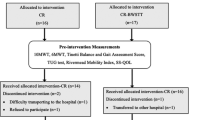Abstract
Background
Flip-flops are a popular footwear choice in warm weather however their minimalist design offers little support to the foot.
Aim
To investigate the effect of flip-flops on lower limb gait kinematics in healthy adults, to measure adherence between the flip-flop and foot, and to assess the effect on toe clearance in swing.
Methods
Fifteen healthy adults (8 male, mean age 27 years) completed a three-dimensional gait analysis assessment using Codamotion. Kinematic and lower limb temporal-spatial data were captured using the Modified Helen Hayes marker set with additional markers on the hallux and flip-flop sole.
Results
Compared to barefoot walking, there were no differences in temporal-spatial parameters walking with flip-flops. There was an increase in peak knee flexion in swing (mean difference 4.6°, 95 % confidence interval (CI) [−5.8°, −3.4°], p < 0.001) and peak ankle dorsiflexion at terminal swing (mean difference 2°, 95 % CI [−3°, −1°], p = 0.001). Other kinematic parameters were unchanged. Peak separation between foot and flip-flop was 8.8 cm (SD 1.48), occurring at pre-swing. Minimum toe clearance of the hallux in barefoot walking measured 4.2 cm (SD 0.8). Minimum clearance of the flip-flop was 1.6 cm (SD 0.56).
Conclusions
Healthy adults adapted well to flip-flops. However, separation of the flip-flop from the foot led to increased knee flexion and ankle dorsiflexion in swing, probably to ensure that the flip-flop did not contact the ground and to maximise adherence to the foot. Minimum clearance of the flip-flop was low compared to barefoot clearance. This may increase the risk of tripping over uneven ground.





Similar content being viewed by others
References
Wegener C, Hunt AE, Vanwanseele B et al (2011) Effect of children’s shoes on gait: a systematic review and meta-analysis. J Foot Ankle Res 4:3. doi:10.1186/1757-1146-4-3
Chard A, Greene A, Hunt A et al (2013) Effect of thong style flip-flops on children’s barefoot walking and jogging kinematics. J Foot Ankle Res 6(1):8. doi:10.1186/1757-1146-6-8
Borland S (2010) Flip-flops ‘injure 200,000 a year’ costing the NHS an astonishing £40 m. http://www.dailymail.co.uk/health/article-1298471/Flip-flops-injure-200-000-year-costing-NHS-astonishing-40m.html. Accessed 02 Jul 2015
Johnson AJ (1967) “Flip flop” sandals. Br Med J 2(5543):55
Sherrington C, Menz HB (2003) An evaluation of footwear worn at the time of fall-related hip fracture. Age Ageing 32(3):310–314
Zhang X, Paquette MR, Zhang S (2013) A comparison of gait biomechanics of flip-flops, sandals, barefoot and shoes. J Foot Ankle Res 6(1):45. doi:10.1186/1757-1146-6-45
Shroyer JF, Weimar WH (2010) Comparative analysis of human gait while wearing thong-style flip-flops versus sneakers. J Am Podiatr Med Assoc 100(4):251–257
Kawamura CM, de Morais Filho MC, Barreto MM et al (2007) Comparison between visual and three-dimensional gait analysis in patients with spastic diplegic cerebral palsy. Gait Posture 25(1):18–24. doi:10.1016/j.gaitpost.2005.12.005
Winter DA (1992) Foot trajectory in human gait: a precise and multifactorial motor control task. Phys Ther 72(1):45–53 (discussion 54-46)
Begg R, Best R, Dell’Oro L, Taylor S (2007) Minimum foot clearance during walking: strategies for the minimisation of trip-related falls. Gait Posture 25(2):191–198. doi:10.1016/j.gaitpost.2006.03.008
Loverro KL, Mueske NM, Hamel KA (2013) Location of minimum foot clearance on the shoe and with respect to the obstacle changes with locomotor task. J Biomech 46(11):1842–1850. doi:10.1016/j.jbiomech.2013.05.002
Gates DH, Dingwell JB, Scott SJ et al (2012) Gait characteristics of individuals with transtibial amputations walking on a destabilizing rock surface. Gait Posture 36(1):33–39. doi:10.1016/j.gaitpost.2011.12.019
Kiernan D, Walsh M, O’Sullivan R et al (2014) The influence of estimated body segment parameters on predicted joint kinetics during diplegic cerebral palsy gait. J Biomech 47(1):284–288. doi:10.1016/j.jbiomech.2013.10.024
Newman CJ, Walsh M, O’Sullivan R et al (2007) The characteristics of gait in Charcot-Marie-Tooth disease types I and II. Gait Posture 26(1):120–127. doi:10.1016/j.gaitpost.2006.08.006
Kiernan D, Walsh M, O’Sullivan R et al (2014) Reliability of the CODA cx1 motion analyser for 3-dimensional gait analysis. Gait Posture 39(Supplement 1):S99–S100. doi:10.1016/j.gaitpost.2014.04.137
Protopapadaki A, Drechsler WI, Cramp MC et al (2007) Hip, knee, ankle kinematics and kinetics during stair ascent and descent in healthy young individuals. Clin Biomech (Bristol, Avon) 22(2):203–210. doi:10.1016/j.clinbiomech.2006.09.010
Berg WP, Alessio HM, Mills EM, Tong C (1997) Circumstances and consequences of falls in independent community-dwelling older adults. Age Ageing 26(4):261–268
Roos PE, Dingwell JB (2013) Using dynamic walking models to identify factors that contribute to increased risk of falling in older adults. Hum Mov Sci 32(5):984–996. doi:10.1016/j.humov.2013.07.001
Shakoor N, Sengupta M, Foucher KC et al (2010) Effects of common footwear on joint loading in osteoarthritis of the knee. Arthritis Care Res 62(7):917–923. doi:10.1002/acr.20165
Carl TJ, Barrett SL (2008) Computerized analysis of plantar pressure variation in flip-flops, athletic shoes, and bare feet. J Am Podiatr Med Assoc 98(5):374–378
Acknowledgments
Funding to author TS was kindly provided by the Royal College of Surgeons in Ireland, Dublin, under its Research Summer School programme. The authors would like to thank Michael Walsh, gait laboratory manager, for facilitating the project.
Author information
Authors and Affiliations
Corresponding author
Ethics declarations
Ethical approval
All procedures performed in this study were in accordance with the ethical standards of the institutional research ethics committee and with the 1964 Helsinki declaration and its later amendments or comparable ethical standards. Informed consent was obtained from all individual participants included in the study.
Rights and permissions
About this article
Cite this article
Sharpe, T., Malone, A., French, H. et al. Effect of flip-flops on lower limb kinematics during walking: a cross-sectional study using three-dimensional gait analysis. Ir J Med Sci 185, 493–501 (2016). https://doi.org/10.1007/s11845-016-1421-y
Received:
Accepted:
Published:
Issue Date:
DOI: https://doi.org/10.1007/s11845-016-1421-y




